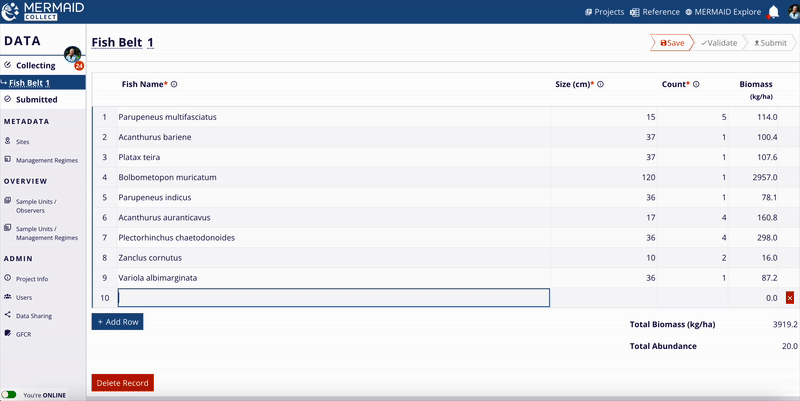When you're ready to enter your fish observations from your dive sheets, navigate to your project's Collecting page and click + Add sample unit. Choose the Fish Belt method to open a sample unit form organized into four main sections: Sample event, Transect, Observers, Observations.
Read more about our fish belt method in Supported Survey Methods.

Completing a fish belt sample unit form
Note: Required fields are marked with a red asterisk (*). These include site, management regime, observers, and key transect attributes. Optional fields include time, visibility, current, tide, and notes. Helper text is available for every field—just click the info icon next to a label to view tips, definitions, and example entries. |
1. Sample event
Defines where and when the fish belt survey was conducted. You'll select:
Site – From the list of sites added to the project. Learn more about adding sites here.
Management regime – From the list of management regimes added to the project. Learn more about adding management regimes here.
Date of survey – The date the sample unit was collected.
Each sample event (site, management regime, and date) is used to group your sample units for the reef health metrics calculations in MERMAID. Read more in Learning about Our Reef Health Metrics.

2. Transect
Protocol-specific fields for the fish belt survey:
Transect number
Depth (m)
Transect length surveyed (m)
Width (m) – This represents the total belt width surveyed combining both sides of the transect line. Options include:
Single-width belts for all fish sizes:
1 m
2 m
4 m
5 m
10 m
20 m
Mixed-width belts depending on fish size, where the width is automatically assigned based on each fish size observed:
<10 cm @ 2 m, ≥10 cm @ 5 m
<20 cm @ 2 m, ≥20 cm @ 4 m
<20 cm @ 4 m, ≥20 cm @ 8 m
≥10 cm & <35 cm @ 5 m, ≥35 cm @ 20 m
If a mixed-width belt option is selected, MERMAID will calculate the effective transect area for each fish record according to the rule.
For instance, under the rule <10 cm @ 2 m, ≥10 cm @ 5 m, a fish measuring 8 cm would be assigned a transect width of 2 m, while a fish measuring 12 cm would be assigned 5 m.
This feature is particularly useful when:
Different belt widths were used for different size classes;
Only one observer collected the data;
You wish to combine all observations into a single sample unit, while still accounting for the correct belt width per fish size.
Fish size bin (cm) – This represents the size class of the fish observed. Options are:
1 cm
5 cm
10 cm
AGRRA (Read more about AGRRA fish protocol here)
WCS India
For fish >50 cm, use the '50+cm' bin and enter exact size.
Optional fields – Reef slope, Visibility, Current, Relative depth, Tide, Notes.
Some fields use standardized dropdowns (e.g., belt width), while others accept numeric or free-text entries (e.g., transect length surveyed).
MERMAID requires you to specify the transect length surveyed and total belt width (m). These inputs are needed to calculate the surveyed area for biomass estimation (kg/ha). For example, a 50 m long transect with a 5 m total width covers 250 m², or 0.025 ha.
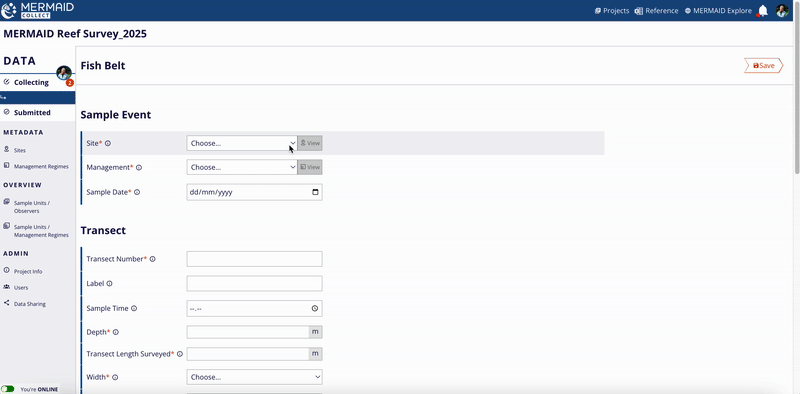
3. Observers
Assign the observer(s) who conducted the survey:
Select from the list of project users
Click to add/remove names
At least one observer is required per sample unit
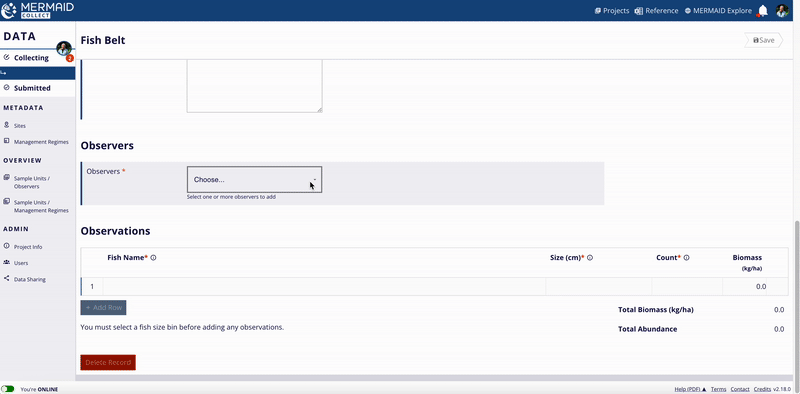
4. Observations
Enter your raw field observations:
Fish name – Enter the observed taxon; this can be at the species, genus, or family level, depending on the precision of your identification.
Size (cm) – Record the estimated total length of the fish (in cm) observed in this row.
Count – Enter the number of individuals observed for that fish name at the specified size.
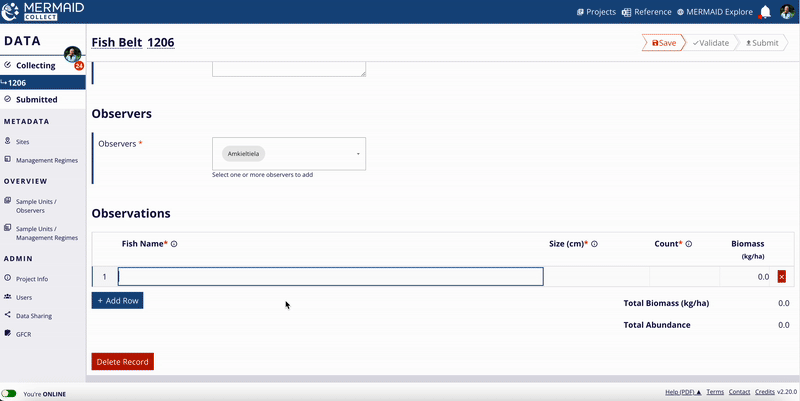
Proposing a new fish species
If a fish species isn’t yet listed in the dropdown:
Type its name in the Observations table.
Select Propose new species….
Select Genus name from the dropdown and enter the Species name.
Click Next to review your suggestion.
Click Send to MERMAID to submit it for review.
If the genus is missing, select Contact us for help to notify the MERMAID team.
The fish taxonomy in MERMAID is standardized using the World Register of Marine Species (WoRMS) to ensure consistent species classification.
Note: Check the species in WoRMS to ensure the species name is accepted before submitting. Your entry will be provisionally included but becomes official only after reviewed and approved by the MERMAID Team. |
You can download the full list of available fish species using the Reference icon in MERMAID Collect.
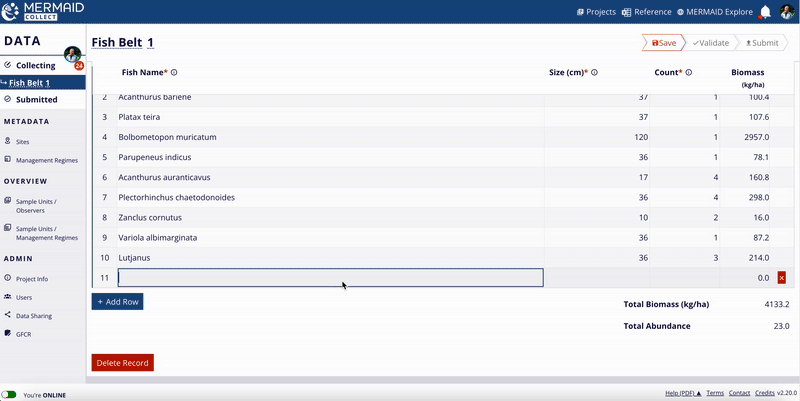
Tips for data entry: Keyboard shortcuts and predictive text
Use these keyboard shortcuts and the predictive text to move quickly through the Observations table in a sample unit form:
Use the Tab key to move across fields in a row.
Use the Up and Down arrow keys to scroll through fish name suggestions.
Under the column Fish name, type a few letters of your observation (e.g., Istpla for Istiophorus platypterus), then use the arrow keys and Enter/Return/Tab to select it from the matching dropdown options. Or type until there’s only one option and press Enter/Return.
Press Tab at the end of a row to duplicate the observation in the next row—useful for entering different size bins for the same fish species in a transect.
Press Enter/Return to start a new row and begin typing the next observation.
This helps ensure consistent naming and speeds up your workflow—especially when entering lots of observations.
Metric summaries in a fish belt sample unit
MERMAID automatically calculates and displays key fish metrics as you enter observations, providing immediate feedback for data validation and quality control—even while offline.
Total biomass (kg/ha) is calculated in real time based on the surveyed area (transect length × belt width), fish size estimates, and counts. Calculations use Bayesian length–weight coefficients sourced from FishBase.
Total abundance (count of individuals) is computed automatically as the sum of all individual fish counts entered in the Observations table.
Reminder: Enter both transect length surveyed and belt width to activate biomass calculations. |
Read more about these calculations in Learning About Our Taxonomic Reference.
